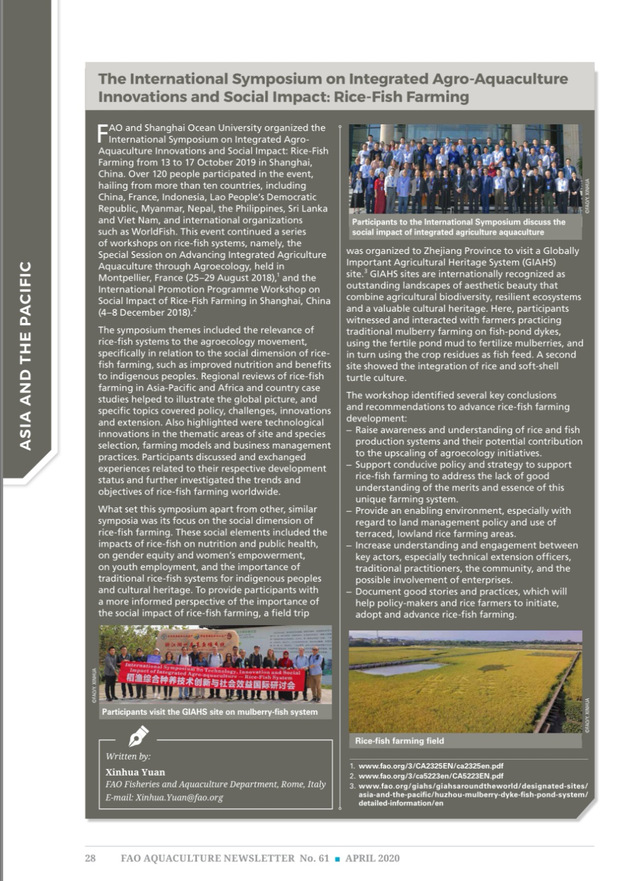FAO Aquaculture Newsletter (FAN) No.61 issued by the Fisheries and Aquaculture Department of the Food and Agriculture Organization of the United Nations (FAO) in April 2020 introduced the International Symposium on Integrated Agro-Aquaculture Innovations and Social Impact: Rice-Fish Farming co-chaired by the FAO and Shanghai Ocean University from 13 to 17 October 2019.

It is reported that over 120 people participated in the symposium, hailing from more than ten countries, including China, France, Indonesia, Lao People’s Democratic Republic, Myanmar, Nepal, the Philippines, Sri Lanka and Vietnam, and international organizations such as FAO, WORLDFISH CENTER, Network of Aquaculture Centres in Asia-Pacific(NACA). The International Symposium on Integrated Agro-Aquaculture Innovations and Social Impact: Rice-Fish Farming in 2019 continued a series of workshops on rice-fish systems, namely, the Special Session on Advancing Integrated Agriculture Aquaculture through Agroecology, held in Montpellier, France (25-29 August, 2018), and the International Promotion Programme Workshop on Social Impact of Rice-Fish Farming in Shanghai Ocean University, China (4-8 December, 2018). Over 50 people participated in the event, hailing from countries including Lao People’s Democratic Republic, Indonesia, Philippines, Vietnam, Kenya, Uganda, France, Japan, and international organizations such as FAO, WORLDFISH CENTER, NACA. This is the second cooperation in the international symposium on the integrated rice-fish farming between Shanghai Ocean University and FAO, and the sixth international events that we cooperate with the Fisheries and Aquaculture Department of the United Nations Food and Agriculture Organization since 2017. 
Judging from the overall situation of rice-fish farming in the world, there are currently more than 160 million hectares of rice fields in the world, and rice-fish farming has great potential for growth. At present, with the increase of the world’s population and changes in eating habits, people’s demand for aquatic products is mounting, and the gap between the supply and demand of aquatic products is widening accordingly. Therefore, as long as rice-fish farming technology can be applied for a small number of rice fields each year, which can produce millions of tons of aquatic products and can also improve the adaptability of rice fields in order to better respond to the impact of climate change. The aquatic products produced in the rice fields can solve the malnutrition of the people in some areas and encourage the farmers to increase income, become rich, and improve food safety. 
In recent years, China’s rice-fish farming industry has achieved a rapid growth. Varieties, breeding models and supporting technologies have been continuously updated, improving the economic and social benefits. The diversified rice-fish farming model, including rice-shrimp, rice-fish, rice-crab, rice-turtle, etc., has not only contributed to achieving good ecological and economic benefits, but also helping farmers get rid of poverty, become rich as well as inherit traditional culture. In 2016, Shanghai Ocean University, the National Fisheries Technology Extension Center and the China Society of Fisheries (CSF) jointly initiated the establishment of the “China Rice-Fish Integrated Farming Industry Technology Innovation Alliance”. It has been actively promoting the advanced concept of grain-based, ecological optimization and industrialization development, focusing on development planning research, production standard formulation and implementation, industrial supporting service system construction, etc., and guiding the healthy development of the rice-fish farming industry standard. Since the 19th National Congress of the Communist Party of China (CPC), in order to implement the new development concept and adhere to high-quality development, the government has taken the implementation of the rural revitalization strategy as the guide, accelerated the construction of the spatial pattern, industrial structure and production mode of the green development of aquaculture and promoted the transformation of China from a large aquaculture country to a strong one. Based on this background, on January 11, 2019, the ten ministries and commissions of China issued “Opinions on Accelerating the Green Development of Aquaculture, which specifically mentioned the promotion of integrated rice-fish farming and the improvement of the comprehensive benefits of rice fields. 
At present, China’s integrated rice-fish farming area has exceeded 2 million hectares, ranking first in the world. The related technologies, management measures and practical experience are also very rich, which can provide Chinese solutions and experience for sustainable development of global rice-fish farming. Dr. Matthias Halwart, the head of Aquaculture Branch in Fisheries and Aquaculture Department from the Food and Agriculture Organization of the United Nations (FAO) and Dr. Huang Jie, the Director General of the Network of Aquaculture Center in Asia-Pacific (NACA), both unanimously emphasized in the symposium the importance of cooperation for development and called for more seminars and other forms to exchange knowledge and share experience. Besides, they also encouraged to further promote the development of rice-fish farming worldwide by the establishment of international and regional cooperative partnerships such as South-South cooperation mode. As the secretary-general unit of China Rice-Fish Integrated Culture and Innovation Technology Alliance, scholars from Shanghai Ocean University have continued to conduct a lot of research and work on integrated rice-fish farming, which has played a good role in leading and promoting industrial development and making important contribution to China and the world. 
The comprehensive rice and fish farming system is a multi-functional eco-production system with a long history and great development potential. Based on the basic original intention of “Two crops for every field”, it has positive benefits in inheritance and protection of traditional culture, poverty reduction, employment increase especially for rural women, enrichment in food supply, agricultural source pollution decrease, biodiversity protection, supply chain expansion, and attracting labor force to work in rural areas. It could help create a beautiful rural landscape, contribute to the development of local tourism. Guided by the China’s rural revitalization strategy, this high-complex system can produce important economic, ecological and social benefits. At the same time, this system is highly praised by FAO and is being promoted globally as a sustainable production model. It can play an active role in the construction of the One Belt and One Road Initiative and the construction of a community with shared future for mankind proposed by China.